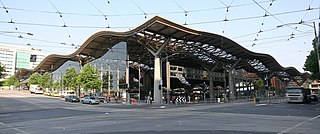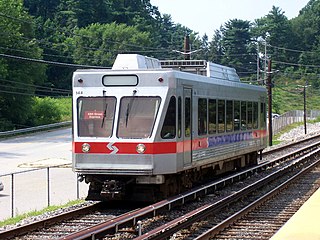
Commuter rail, or suburban rail, is a passenger rail transport service that primarily operates within a metropolitan area, connecting commuters to a central city from adjacent suburbs or commuter towns. Commuter rail systems are considered heavy rail, using electric or diesel trains. Distance charges or zone pricing may be used.
In public transit, particularly bus, tram, or train transportation, a limited-stop service is a trip pattern that stops less frequently than a local service. Many limited-stop or semi-fast services are a combination of commuter rail and express train.

Inter-city rail services are express trains that run services that connect cities over longer distances than commuter or regional trains. They include rail services that are neither short-distance commuter rail trains within one city area nor slow regional rail trains stopping at all stations and covering local journeys only. An inter-city train is typically an express train with limited stops and comfortable carriages to serve long-distance travel.

Southern Cross railway station is a major railway station in Docklands, Melbourne. It is on Spencer Street, between Collins and La Trobe streets, at the western edge of the Melbourne central business district. The Docklands Stadium sports arena is 500 metres north-west of the station.

The Norristown High Speed Line is a 13.4-mile (21.6 km) interurban light rapid transit line operated by SEPTA, running between the 69th Street Transportation Center in Upper Darby and the Norristown Transportation Center in Norristown, Pennsylvania. Originally the Philadelphia and Western Railroad line, the line runs entirely on its own right-of-way. By 2020, the Norristown High Speed Line had an average weekday ridership approaching 11,000 passengers.

The Great Western Main Line (GWML) is a main line railway in England that runs westwards from London Paddington to Bristol Temple Meads. It connects to other main lines such as those from Reading to Penzance and Swindon to Swansea. The GWML is presently a part of the national rail system managed by Network Rail while the majority of passenger services upon it are provided by the current Great Western Railway franchise.

Meadowhall Interchange is a transport interchange located in north-east Sheffield, consisting of a combined heavy rail station, tram stop and bus and coach station. The second-busiest heavy rail station in the city in terms of passenger numbers, Meadowhall Interchange provides connections between National Rail services, the Sheffield Supertram light rail network, intercity coach services and the city bus network.
Skip-stop is a public transit service pattern which reduces travel times and increases capacity by having vehicles skip certain stops along a route. Originating in rapid transit systems, skip-stop may be also used in light rail and bus systems.

Ashford International railway station is a National Rail station in Ashford, Kent, England. It connects several railway lines, including High Speed 1 and the South Eastern Main Line. Services are operated by Southeastern and Southern.
Various terms are used for passenger railway lines and equipment; the usage of these terms differs substantially between areas:

Wigan North Western railway station is one of two railway stations serving the town centre of Wigan, Greater Manchester, England.

Chinley railway station serves the rural village of Chinley in Derbyshire, England. The station is 17+1⁄2 miles (28.2 km) south east of Manchester Piccadilly, on the Hope Valley Line from Sheffield to Manchester. It is unstaffed and is managed by Northern Trains.

Passenger rail transport is one of the principal means of transport in the People's Republic of China, with rail passenger traffic exceeding 1.86 billion railway trips in 2011. It is operated by the China Railway Corporation (CR). The Spring Festival Travel Season is the peak railway travel season of the year.

The Great Northern route, formerly known as Great Northern Electrics, is the name given to suburban rail services run on the southern end of Britain's East Coast Main Line and its associated branches. Services operate to or from London King's Cross and London Moorgate. Destinations include Hertford North, Welwyn Garden City, Stevenage, and Cambridge, and in peak hours, additional services run to Peterborough and King's Lynn. Services run through parts of Greater London, Hertfordshire, Bedfordshire, Cambridgeshire, and Norfolk.
A limited express is a type of express train, and express bus service. It refers to an express service that stops at a limited number of stops in comparison to other express services on the same or similar routes.

A passenger train is a train used to transport people along a railroad line. These trains may consist of unpowered passenger railroad cars hauled by one or more locomotives, or may be self-propelled; self propelled passenger trains are known as multiple units or railcars. Passenger trains stop at stations or depots, where passengers may board and disembark. In most cases, passenger trains operate on a fixed schedule and have priority over freight trains.
Railway companies in Europe assign their trains to different categories or train types depending on their role. Passenger trains may be broadly split into long-distance and local trains; the latter having average journey times of under an hour and a range of less than 50 kilometres. Goods trains have their own train types. The names of these train types have changed continually over the course of time.

Manchester Airport High Speed Station was a planned High Speed 2 station at Manchester Airport, on the southern boundary of Manchester, England, next to Junction 5 of the M56 motorway on the northern side of the airport 1.5 miles (2.4 km) north-west of Manchester Airport railway station.

Northern Powerhouse Rail (NPR), sometimes referred to unofficially as High Speed 3, is a proposed major rail programme designed to substantially enhance the economic potential of the North of England. The phrase was adopted in 2014 for a project featuring new and significantly upgraded railway lines in the region. The aim is to transform rail services between the major towns and cities, requiring the region's single biggest transport investment since the Industrial Revolution. The original scheme would have seen a new high-speed rail line from Liverpool to Warrington continuing to join the HS2 tunnel which it would share into Manchester Piccadilly station. From there, the line would have continued to Leeds with a stop at Bradford. The line was intended to improve journey times and frequency between major Northern cities as well as creating more capacity for local service on lines that express services would have been moved out from.

Route capacity is the maximum number of vehicles, people, or amount of freight than can travel a given route in a given amount of time, usually an hour. It may be limited by the worst bottleneck in the system, such as a stretch of road with fewer lanes. Air traffic route capacity is affected by weather. For a metro or a light rail system, route capacity is generally the capacity of each vehicle, times the number of vehicles per train, times the number of trains per hour (tph). In this way, route capacity is highly dependent on headway. Beyond this mathematical theory, capacity may be influenced by other factors such as slow zones, single-tracked areas, and infrastructure limitations, e.g. to useful train lengths.

















